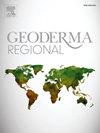Subsurface drainage and nitrogen management affects soil properties in upstate Missouri U.S.
IF 3.1
2区 农林科学
Q2 SOIL SCIENCE
引用次数: 0
Abstract
Enhanced efficiency nitrogen (N) fertilizer management may reduce environmental N losses and increase grain yields. The effect of N fertilizer management practices on soil properties is uncertain. In this 5-year study, we evaluated different N fertilizer management [non-treated control (NTC), fall applied anhydrous ammonia (AA) 190 kg N ha−1 with nitrapyrin (fall AA + NI), preplant AA at 190 kg N ha−1 (spring AA), top-dressed urea (TD urea) as 42 kg N ha−1 SuperU and 126 kg N ha−1 ESN as a 25:75 % granular blend] practices in free drained (FD) and non-drained (ND) soils for their impact on soil properties. In FD soils, N fertilization significantly (P < 0.05) increased soil pH, CEC, cations, and Bray I P compared to the NTC. Improved soil aeration and increased plant growth with TD urea and spring AA fertilizer treatments in FD soils increased soil organic matter (OM) 10–13 % and total organic carbon (TOC) 27–35 % compared to the NTC. Increased clay content and reduced silt content were observed in FD soils with N fertilizer treatments compared to NTC. However, fertilizer applications in ND soils had no effect on soil properties. Increased crop production with FD and 4R N fertilizer applications can improve soil properties with increased soil OM and TOC content. This suggests that a synergetic effect of N fertilization and soil drainage can improve soil health by increasing soil cation exchange capacity (CEC), OM, and TOC content.
地下排水和氮肥管理对美国密苏里州北部土壤特性的影响
提高氮(N)肥管理效率可减少环境中的氮损失,提高谷物产量。氮肥管理方法对土壤性质的影响尚不确定。在这项为期 5 年的研究中,我们评估了自由排水土壤(FD)和非排水土壤(ND)中不同的氮肥管理方法[未处理对照(NTC)、每公顷 190 千克氮的秋季施用无水氨(AA)和硝基吡啉(秋季 AA + NI)、每公顷 190 千克氮的播种前 AA(春季 AA)、每公顷 42 千克氮的超级尿素(TD 脲)和每公顷 126 千克氮的 ESN(25:75 % 颗粒混合物)]对土壤性质的影响。与 NTC 相比,在 FD 土壤中施用氮肥能显著(P < 0.05)提高土壤 pH 值、CEC、阳离子和 Bray I P。与 NTC 相比,在 FD 土壤中施用 TD 尿素和春季 AA 肥料可改善土壤通气性并促进植物生长,使土壤有机质(OM)增加 10-13%,总有机碳(TOC)增加 27-35%。与 NTC 相比,FD 土壤中的氮肥处理增加了粘土含量,减少了淤泥含量。然而,在 ND 土壤中施肥对土壤性质没有影响。通过施用 FD 和 4R 氮肥来提高作物产量,可以提高土壤 OM 和 TOC 含量,从而改善土壤性质。这表明,氮肥施用和土壤排水的协同效应可以通过增加土壤阳离子交换容量(CEC)、OM 和 TOC 含量来改善土壤健康。
本文章由计算机程序翻译,如有差异,请以英文原文为准。
求助全文
约1分钟内获得全文
求助全文
来源期刊

Geoderma Regional
Agricultural and Biological Sciences-Soil Science
CiteScore
6.10
自引率
7.30%
发文量
122
审稿时长
76 days
期刊介绍:
Global issues require studies and solutions on national and regional levels. Geoderma Regional focuses on studies that increase understanding and advance our scientific knowledge of soils in all regions of the world. The journal embraces every aspect of soil science and welcomes reviews of regional progress.
 求助内容:
求助内容: 应助结果提醒方式:
应助结果提醒方式:


